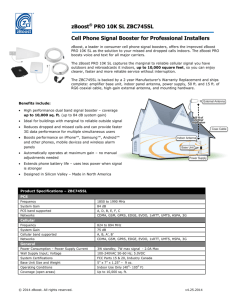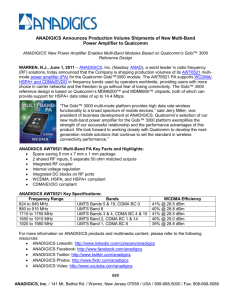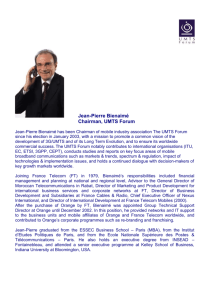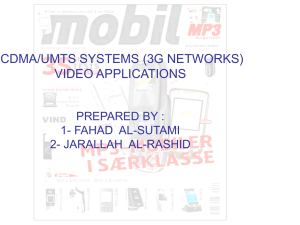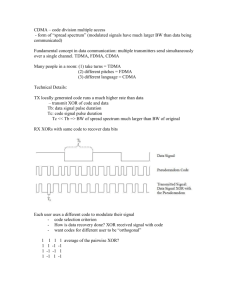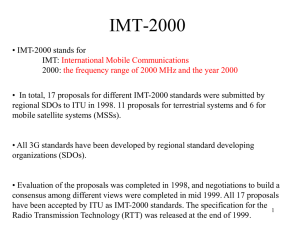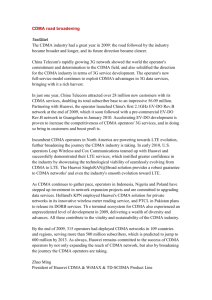PPT - TML
advertisement
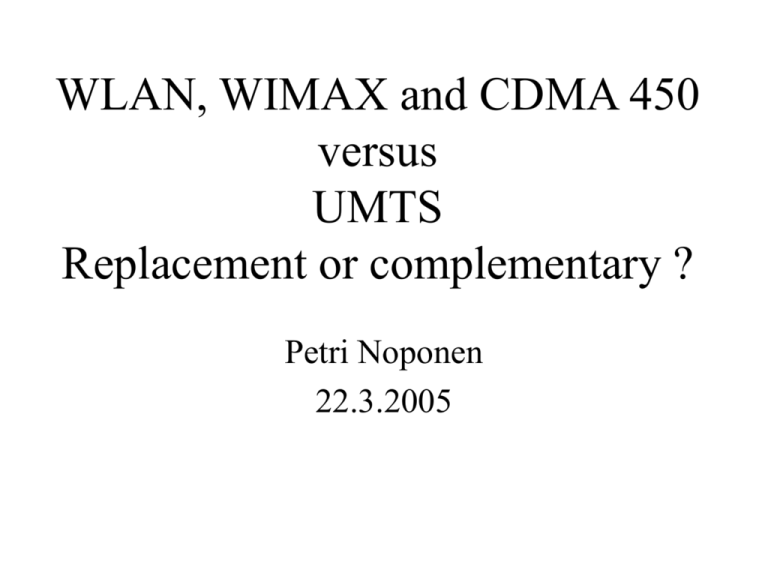
WLAN, WIMAX and CDMA 450 versus UMTS Replacement or complementary ? Petri Noponen 22.3.2005 AGENDA • • • • • WLAN WIMAX CDMA 450 COMPARISON CONCLUSIONS WLAN – IEEE 802.11 • • • • Synonyms: WiFi, WLAN, 802.11x 802.11 802.11b (11 Mbit/s) 802.11a (54 Mbit/s) WLAN – UMTS WiMAX - IEEE 802.16 • • • • • MAN, Metropolitan Area Network IEEE 802.16 Point-to-point, point-to-multipoint Cable replacement, ”last mile wireless” Mobility – coming near future ? WiMAX - IEEE 802.16 WiMAX - IEEE 802.16 WiMAX - IEEE 802.16 CDMA 450 • • • • CDMA 2000 1xRTT CDMA 2000 1xEV (evolution) CDMA 2000 1x EV-DO (evolution data only) BTS’s frequency adjusted to 450 MHz • • • • CDMA 450 networks Eurotel in the Czech Republic TRIATEL (formely Telecom Baltjia) in Latvia UralWestcom in Russia CDMA 450 CDMA2000 1x EV (IS-856 TIA/EIA ) Forward link Reverse link CDMA 450 CDMA2000 1x EV (IS-856 TIA/EIA ) CDMA 450 CDMA2000 1x EV-DO (IS-856) CDMA 450 Nortel 1x EV-DO 450/800/1900 MHz Base Station CDMA 450 Nortel 1x EV-DO CDMA 450 • • • • Nortel alliance : Curitel, Synertek, and AnyData (terminal, modems) QTP-5500 1xEV-DO Test Phone (Qualcomm) 450 MhZ Data call over 1xRTT Analysis - Porter 5 forces Threat of New Entrants POTENTIAL ENTRANTS Bargaining Power of Suppliers SUPPLIERS Bargaining Power of Buyers INDUSTRY COMPETITORS Intensity of Rivalry SUBSTITUTES Threat of Substitutes BUYERS Analysis - Porter 5 forces • Portel’s model in practice • Portel’s model is for industry producing goods. Thus it does not fit well to industry, which product is connectivity service. How ever the connectivity is sell as good for user and the service provided over the connectivity is creating more value user. • UMTS provides users wide range of cellular services. UMTS is available in biggest cities. The UMTS operator are also GSM operators. The GSM network provides service outside UMTS networks. • UMTS operators have large GSM customer basis and established organization to serve users. Operators have also working profitable business model and longer term experience about cellular business. Analysis - Porter 5 forces • Bargaining power of Suppliers • The financially hard times for operators have also cause vendor difficulties. For that reason vendor are willing to make good deal to grow the UTMS market worldwide. Analysis - Porter 5 forces • Bargaining power of buyers • Ordinary users are not very interested to trying complicated thinks on their own. If the UTMS operator can provide everything from support to connectivity to users, then users are not even willing to bargain. Also the users does not yet have understanding how to measure the price of the UMTS services against the value added to users. Analysis - Porter 5 forces • Threat of new entrants • The CDMA 450 will be real competitor for UMTS. Mobility, services and plans to establish wide rural area network are going challenge the UMTS. CDMA 450 has also lower infrastructure cost than UMTS because of the bigger cell size. However the CDMA 450 is not compete with UMTS in cities. Analysis - Porter 5 forces • Threat of substitutes • There is not direct substitutes for UMTS in density traffic areas, the WLAN might compete in hotspots providing internet and VOIP calls. Analysis - Porter 5 forces • Industry Competitors • UMTS operators are trying to attract more new UMTS users, so the competition between UMTS operators is in healthy level. Analysis – Porter Generic Business-Level Stategies Competitive advantage Competitive Scope Lower Cost Differentiation Broad target CDMA 450 UMTS Narrow Target WLAN WiMAX Analysis – Porter Generic Business-Level Stategies • UMTS and CDMA 450 are real competitors. They have similar infrastructure, customer needs and services. The UMTS has competitive advantage in cities by established infrastructure and customer basis. The CDMA 450 is going to grow win users in rural areas, where UTMS infrastructure will be expensive to deploy. Analysis – Porter Generic Business-Level Stategies • WLAN is technology with very limited coverage, but high bandwidth in unlicensed spectrum. WLAN could provide mobility for users. WLAN could provide internet and VOIP calls, but not wide coverage on its own. Analysis – Porter Generic Business-Level Stategies • WiMAX is not competing other, it is wireless cable replacement technology, which competes with wired operators. CONCLUSIONS • WiMAX is more like cable replacement technology, than real competitor of UMTS. AlsoWiMAX does not support at the moment mobility of terminal. • WLAN is hotspot technology providing more capacity to small area than UMTS. WLAN is more complementary technology for UMTS in hotspots. • CDMA 450 is real competitor for UMTS. CDMA 450 provides similar voice and data services as UMTS.
